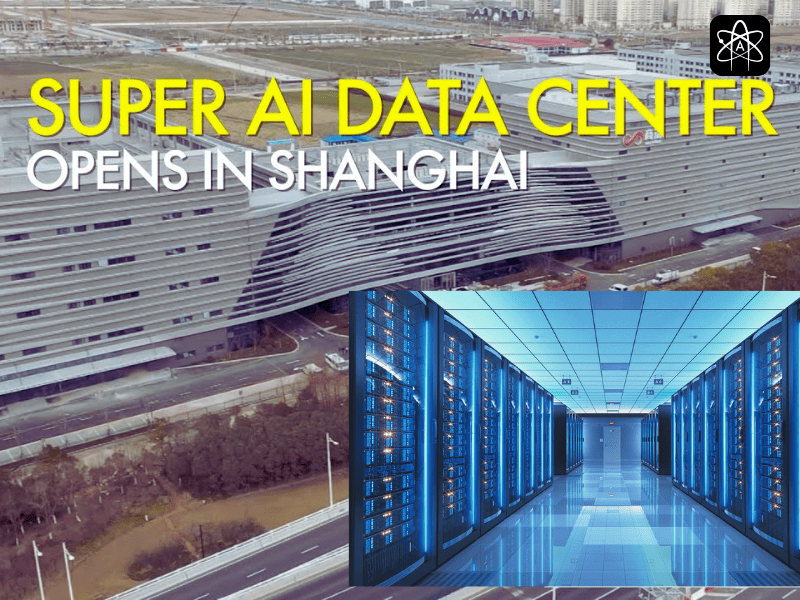To have a rigid place as a global AI superpower, in a bold move, Shanghai targets 5 new data hubs in 2025. This action showcases the aggressive push of China to take over artificial intelligence globally through computational capabilities and a great infrastructure.
This plan is an initiative of a huge Chinese investment strategy, created to support the rising requirements of next-generation AI applications. Shanghai AI data hubs will offer support for big data, machine learning, and also for the smart city technologies by having 5 cutting-edge data centers.
The vision of Shanghai: AI capital of Asia
Shanghai targets 5 new data hubs. This approach shows a long-term vision of this city to be known as the AI capital of Asia. These data hubs are not meant to be just huge storage firms- they will also be green, intelligent, and analyzed for top-performing compute to scale AI algorithms at fuel.
As China’s infrastructure growth is rising, these data hubs will be created to organize everything, from real-time cloud services to LLM training datasets. By having this computing power distributed across Shanghai, China is prepared for a future data-intensive in robotics, finance, healthcare, and transportation.
Why introduce 5 new data hubs now?
Timing should always be perfect, as it is everything. Shanghai targets 5 new data hubs in 2025. This fact showcases strategic alignment and urgency. With worldwide requirements for artificial intelligence computing growing exponentially, Europe and Silicon Valley have gained enough popularity, and China does not want to be left behind.
These 5 new data hubs are also created as a backbone for homegrown tech giants like Alibaba, Baidu, and Huawei that are growing their alternatives to GPT-4 and ChatGPT, and national artificial intelligence models. This highlights an essential pivot in the China AI investment strategy towards self-reliance and domestic innovation.
Infrastructure created for the growth of AI
Shanghai targets 5 new data hubs; these are not just any traditional data centers. The aim behind creating this is to have facilities for exascale computations and petascale, AI-based chip compatibility, and low-latency networks. Huawei Ascend chips, Think NVIDIA GPUs, and custom accelerators are all structured for deep learning.
This kind of structure is necessary for managing workloads of artificial intelligence that span real-time video, various languages, AI research, and autonomous driving. With this growth, Shanghai AI data hubs are anticipated to match their counterparts in Europe and the U.S.
Strategically aligning with national policies.
Shanghai targets 5 new data hubs as a part of the “East-to-West Computing Resource Transfer”, which is an initiative taken by the Chinese government. This national policy helps to scale effective allocation of data processing among western rural areas and eastern urban regions.
This initiative is known to underscore China’s AI growth as it prioritizes digital balance, efficiency, and sustainable development. By focusing on efficient data hubs in Shanghai, China builds a tech way linking talent, data, and policy into an innovation ecosystem that is unified.
Sustainable focus on the Green AI model
China is creating these hubs for both sustainability and performance. As Shanghai targets 5 new data hubs, renewable power resources, energy-efficient coding, and smart management systems are all part of creating these. This policy also aligns with the carbon neutrality goals of China for 2060.
These eco-conscious facilities of artificial intelligence showcase a transformation in how Shanghai AI data hubs are being created- not only to decrease carbon emissions but also to increase intelligence, which sets a new worldwide example in green AI models.
Scaling the Tech ecosystem of Shanghai
Shanghai targets 5 new data hubs; this decision is a boost for the research institutions and quickly scaling AI-based startups of the city. By having direct access to computing power, there are organizations that can conduct complicated simulations, train larger models, and launch commercial applications quickly.
This impacts sectors like smart manufacturing, autonomous vehicles, and biotech directly. As the China AI investment strategy reveals, Shanghai tends to attract candidates and international partnerships wanting to tap into the most ambitious artificial intelligence infrastructure program in the world.
Competitive Placing and Global Implications
Shanghai targets 5 new data hubs to compete on a global scale worldwide and increase local capabilities. By building the backbone of the model, China places Shanghai as an artificial intelligence export hub that can support digital trade and service foreign markets.
It also signals a clear message that China is still relevant in the market, to various tech powers like India, the U.Ss, and the EU. It is creating an ammeter, faster, and greener in its race of domination in artificial intelligence, as shown by the faster pace of China’s AI infrastructure growth.
Read More: OpenAI Offer Triggers Meta : The High-Stakes Battle for AI Talent in 2025
Read More: Destinus-Daedalean Acquisition of $223M Marks New Defence Tech Deal
Conclusion
Shanghai targets 5 new data hubs in 2025; it is a foundational chance in the quest of China for AI supremacy and is not just a standalone approach taken. Backed up by funding, policy, and innovation, these data hubs powered by AI will reshape the tech environment of Shanghai and tighten the worldwide position of China.
As the Shanghai AI data hubs are growing, they showcase a huge narrative: that model is destiny in the era of AI, and Shanghai is creating both China’s one data center and its future.
FAQs
What is the role of these hubs in the growth of China’s infrastructure?
They offer running large-scale applications and computing power for training AI models.
Are these data hubs in Shanghai eco-friendly?
Yes, they aim for green cooling systems, green cooling efficiency, and renewable energy integration.
Why do Shanghai targets 5 new data hubs in 2025?
To support national digital infrastructure development and tighten the AI capabilities of China.



